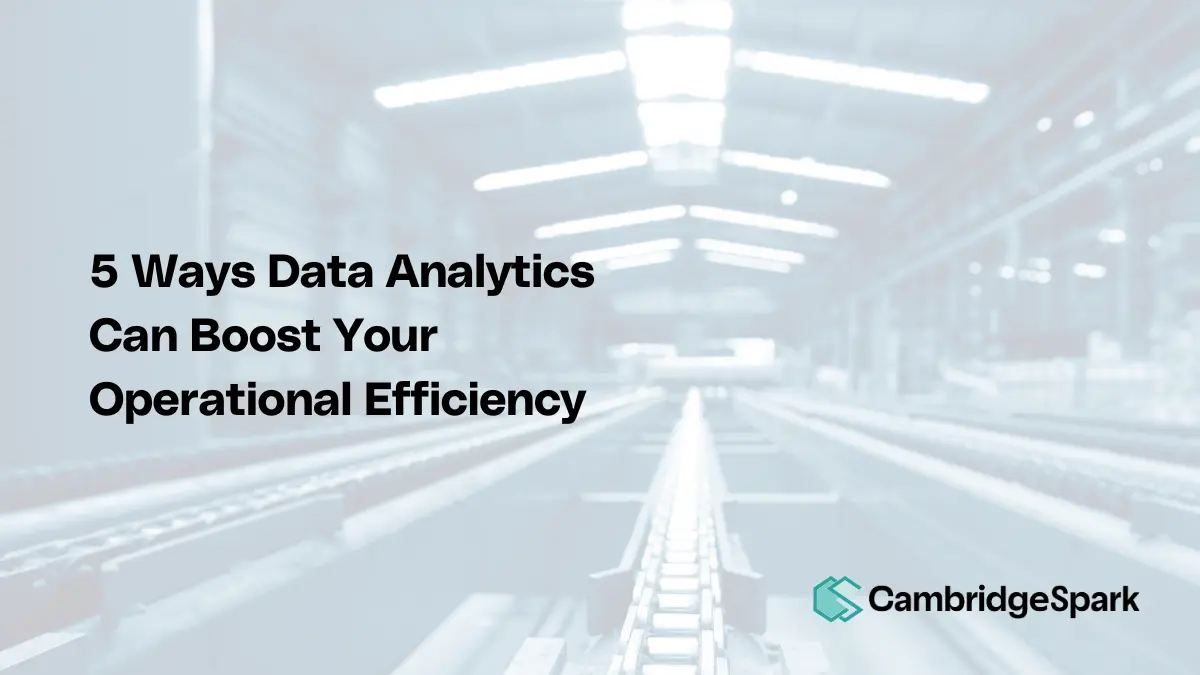As the old saying goes, “work smarter, not harder”. And data analytics is the perfect example of how organisations like yours are doing this.
Data analytics is a major force behind today's business strategies, transforming raw data into actionable insights. It's the key to unlocking trends, decoding customer behaviour, and steering companies towards smarter decisions.
Operational efficiency is all about ensuring organisations deliver top-notch products or services while allocating their resources effectively.
This involves optimising processes, resources, and technology to maximise productivity and reduce waste. It means ensuring that every aspect of operations is aligned to enhance performance, lower operational costs, and improve customer satisfaction.
And efficiency is crucial for businesses aiming for sustainable growth and competitiveness in their industry.
So what are the potential benefits of improved operational efficiency for your business? Here are some examples:
- Reduced costs
- Higher revenue and profitability
- Shorter lead times
- Better customer satisfaction
- Better staff engagement and retention
- Higher productivity levels
- Greater sustainability
Excited to learn how data analytics can bring you operational efficiency and all the benefits that confers? Let’s jump into our list of 5 ways.
1. Use data to drive decision making
Data analytics is crucial in guiding businesses towards more informed decision-making.
The era of relying on intuition and traditional guesswork is gone. And analytics has made room for data-driven strategies, allowing organisations to forge ahead with more confidence than ever.
Using data analytics for informed decision-making begins with gathering and analysing relevant data from various sources. These sources could be customer feedback, sales reports, and market trends.
Analysing this treasure trove of information often reveals patterns and insights that might otherwise remain hidden. By understanding these patterns, you can make important business decisions that are backed by concrete data.
 “I knew if we were going to become more data-driven in our decision making, then I needed to equip myself with all the right tools to support the business in making those decisions. So when I heard about the apprenticeship I thought, 'That’s exactly what I need!” Lisa Cooney, TrendBible
“I knew if we were going to become more data-driven in our decision making, then I needed to equip myself with all the right tools to support the business in making those decisions. So when I heard about the apprenticeship I thought, 'That’s exactly what I need!” Lisa Cooney, TrendBible
Embracing data analytics for decision making empowers businesses to replace uncertainty with clarity.

2. Automate your processes
Automating everyday processes is not a luxury. It’s a necessity for improving operational efficiency.
Data analytics helps companies shift from manual, time-consuming tasks to automated, efficient systems. This often frees up valuable resources for more value-add or strategic activities.
A crucial tool used in data analysis that makes automation of processes possible is Python. Python’s simplicity,vast ecosystem of libraries, and cross-compatibility make it a powerful tool.
Professionals working across functions like marketing, supply chain and customer support are writing Python scripts to automate tasks like report generation, inventory management and even email marketing. And this automation leads to reduced manual effort and errors.
Elle Neal, Data Scientist from BPA Quality saved her organisation 48 hours per month by switching from manual Excel spreadsheets to Python for data processing work. Elle also simultaneously increased leads by 13X. This is a fantastic example of how using data analytics can boost operational efficiency.
Organisations adopting data analytics for better efficiency have also pointed to impact on larger, more complex data processing tasks:
 “The stuff that really caught the attention of the management team was a lot of the automation work the team was doing—using Python scripts to automate very complex, large data processing jobs. Automating manual processes and creating ML-powered recommendation engines was where we were freeing up a lot of time for the teams and very quickly making an impact and ROI.” Jonathan Wagstaff, Director of Market Intelligence at DCC Technology.
“The stuff that really caught the attention of the management team was a lot of the automation work the team was doing—using Python scripts to automate very complex, large data processing jobs. Automating manual processes and creating ML-powered recommendation engines was where we were freeing up a lot of time for the teams and very quickly making an impact and ROI.” Jonathan Wagstaff, Director of Market Intelligence at DCC Technology.
With all the time data analytics is saving organisations today through automation, it’s easy to see why “Data Analysts and Scientists” roles are in the top 10 jobs expected to grow fastest between 2023 and 2027.
.webp?width=1050&height=591&name=Python%20(1).webp)
3. Optimise your resources
Optimising resources is not just about cutting costs but also maximising value from all of an organisation’s assets. And data analytics offers you the tools to elevate your operational efficiency on both fronts.
Data analytics can help you identify both areas of excess and untapped resources—from talent to inventory and beyond. Once you’ve gathered insights from across your organisation, you can then allocate resources more effectively to ensure that each asset is used where it brings the most value.
For instance, analytics can reveal the most productive times and conditions for manufacturing operations, leading to energy savings and increased output. In human resources, data can identify skill gaps and optimise workforce deployment, enhancing productivity.
Joel Hollingsworth, Electrophysiology Co-ordinator at the University Hospitals Coventry and Warwickshire (UHCW) NHS Trust, used his data analysis skills to uncover a better strategy for coordinating procedures around recovery times and nurse schedules.
Because of Joel’s upskilling in data analytics, the Trust now prioritises procedures with longer recovery in the morning, so patients can receive their full recovery care time without nurses having to work overtime.
Ultimately, data analytics transforms resource optimisation from a guessing game into a precise, strategic process.

4. Use predictive analytics for forecasting
Predictive analytics empowers businesses to anticipate the future, rather than merely reacting to the past and present. This forward-thinking approach enables companies to streamline their operations, minimise risks, and seize opportunities ahead of the competition.

“We do quite a lot of reporting using past data to find trends. But learning tools like predictive modelling will help us use data to improve our forecasting and optimise working capital.” Guillermo Dominguez, Purchasing Finance Analyst, Exertis
Predictive analytics leverages historical data patterns to forecast future trends, demands, and events. By applying machine learning algorithms and statistical models, businesses can predict customer behaviour, market dynamics, and potential operational bottlenecks.
This foresight allows for proactive decision-making, optimising everything from inventory levels to workforce allocation, ensuring resources are perfectly aligned with future needs.
For instance, David Howell, Joint Director for Strategic Insight and Analytics at Surrey Heartlands Health and Care Partnership, reliably predicted 70-80% of emergency readmissions by building a machine learning model.
By predicting these emergency readmissions, Surrey Heartlands Health and Care Partnership had an even better chance of preventing them, saving time and resources.
This strategic application of data analytics not only enhances operational efficiency but also drives a competitive advantage, positioning organisations for success in a data-driven future.

5. Make your data more accessible
Data has been dubbed “the new oil”, fuelling businesses towards unprecedented growth and efficiency. Yet, the true power of this resource lies not just in its collection but in its accessibility across an organisation.
Data analytics helps make data more accessible and a game-changer for operational efficiency, democratising information and empowering decision-makers at all levels.
And apart from expanded access, employees can be confident that they are all working with the same data.
Data accessibility tools and platforms, such as dashboards and centralised databases, enable staff to retrieve real-time insights relevant to their roles without the bottleneck of gatekeepers or IT departments.
This immediacy in accessing data means that responses to market changes, customer feedback, and internal process adjustments can be fast and based on the latest information.
Accessible data fosters a culture of transparency and collaboration. Teams can easily share insights, identify trends, and work together on data-driven strategies. It also encourages innovation, as employees at all levels have the information they need to propose solutions.
 “My team saw the value of data science with Cambridge Spark. Being part of a global organisation such as Visa, teams in other regions would see the benefits of my projects and begin to reach out with enquiries. I would help them in building reports and dashboards relevant to their own unique requirements, as well as provide training to enable self-sufficiency going forward.” Imran Ayad, Data Analyst, Visa
“My team saw the value of data science with Cambridge Spark. Being part of a global organisation such as Visa, teams in other regions would see the benefits of my projects and begin to reach out with enquiries. I would help them in building reports and dashboards relevant to their own unique requirements, as well as provide training to enable self-sufficiency going forward.” Imran Ayad, Data Analyst, Visa
Enhancing the accessibility of data within a business does not just streamline operations. It transforms the organisation into a more agile, informed, and cohesive unit.
-1.webp?width=1050&height=591&name=Blog%20images%20(3)-1.webp)
Conclusion
The transformative power of data analytics in enhancing operational efficiency is undeniable. Organisations can flourish by embracing strategies such as automation, resource optimisation, predictive forecasting, and making data more accessible. And in doing so, many such organisations significantly improve their productivity, reduce costs, and strengthen their competitiveness.
Are you or your team interested in upskilling in data analytics? Improve your organisation’s operational efficiency today and get in touch via the form below or learn more by taking a look at our Level 4 Data Analytics apprenticeship.

-1.png)

 “I knew if we were going to become more data-driven in our decision making, then I needed to equip myself with all the right tools to support the business in making those decisions. So when I heard about the apprenticeship I thought, 'That’s exactly what I need!”
“I knew if we were going to become more data-driven in our decision making, then I needed to equip myself with all the right tools to support the business in making those decisions. So when I heard about the apprenticeship I thought, 'That’s exactly what I need!”
 “The stuff that really caught the attention of the management team was a lot of the automation work the team was doing—using Python scripts to automate very complex, large data processing jobs. Automating manual processes and creating ML-powered recommendation engines was where we were freeing up a lot of time for the teams and very quickly making an impact and ROI.”
“The stuff that really caught the attention of the management team was a lot of the automation work the team was doing—using Python scripts to automate very complex, large data processing jobs. Automating manual processes and creating ML-powered recommendation engines was where we were freeing up a lot of time for the teams and very quickly making an impact and ROI.” .webp?width=1050&height=591&name=Python%20(1).webp)



 “My team saw the value of data science with Cambridge Spark. Being part of a global organisation such as Visa, teams in other regions would see the benefits of my projects and begin to reach out with enquiries. I would help them in building reports and dashboards relevant to their own unique requirements, as well as provide training to enable self-sufficiency going forward.”
“My team saw the value of data science with Cambridge Spark. Being part of a global organisation such as Visa, teams in other regions would see the benefits of my projects and begin to reach out with enquiries. I would help them in building reports and dashboards relevant to their own unique requirements, as well as provide training to enable self-sufficiency going forward.” -1.webp?width=1050&height=591&name=Blog%20images%20(3)-1.webp)